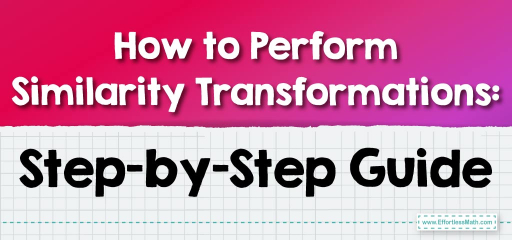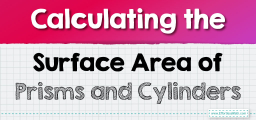How to Perform Similarity Transformations: Step-by-Step Guide
In the intricate world of geometry, transformations play a pivotal role. They allow us to visualize, understand, and describe changes in the position, size, and orientation of figures. Among these transformations, 'Similarity Transformations' stand out as fascinating tools that change the size but not the shape of figures. They preserve angles, parallel lines, and proportions. Ready to dive deeper? Let's unravel the world of Similarity Transformations and their applications.

Step-by-step Guide: Similarity Transformations
Basics of Transformations:
Transformations in geometry refer to operations that alter the position, size, or orientation of a figure. These can include translations (slides), rotations (turns), reflections (flips), and dilations (resizing).
Defining Similarity Transformations:
Similarity transformations are a subset of transformations that change the size of a figure without changing its shape. The primary similarity transformation is dilation.
Dilation – The Core of Similarity Transformation:
Dilation is a transformation that produces an image that is the same shape as the original, but is a different size. It involves enlarging or reducing a figure proportionally.
- Center of Dilation: A fixed point in the plane.
- Scale Factor: The ratio by which a figure is enlarged or reduced. A scale factor greater than \(1\) results in an enlargement, while a scale factor between \(0\) and \(1\) results in a reduction. The formula for dilation from a center point \((x, y)\) with a scale factor \(k\) is:
\( (x’, y’) = (x \cdot k, y \cdot k) \)
Examples
Example 1:
A rectangle has vertices at \(A(2,3)\), \(B(8,3)\), \(C(8,6)\), and \(D(2,6)\). Find the vertices of the rectangle after a dilation with a scale factor of \(2\), centered at the origin.
Solution:
Using the dilation formula:
\( A'(4,6), B'(16,6), C'(16,12), ) and ( D'(4,12) \).
Example 2:
A triangle has vertices at \(P(1,1)\), \(Q(4,1)\), and \(R(2,5)\). Determine the vertices of the triangle after a dilation with a scale factor of \(0.5\), centered at the origin.
Solution:
Applying the dilation formula:
\( P'(0.5,0.5), Q'(2,0.5), \) and \( R'(1,2.5) \).
Practice Questions:
- A square has vertices at \(E(3,4)\), \(F(6,4)\), \(G(6,7)\), and \(H(3,7)\). What are the vertices of the square after a dilation with a scale factor of \(3\), centered at the origin?
- A rhombus has vertices at \(I(-2,3)\), \(J(2,5)\), \(K(4,3)\), and \(L(0,1)\). Determine the vertices of the rhombus after a dilation with a scale factor of \(0.25\), centered at the origin.

Answers:
- \(E'(9,12)\), \(F'(18,12)\), \(G'(18,21)\), and \(H'(9,21)\)
- \(I'(-0.5,0.75)\), \(J'(0.5,1.25)\), \(K'(1,0.75)\), and \(L'(0,0.25)\)
Related to This Article
More math articles
- 5 Tips to Help You Learn Math Faster
- 4th Grade MCAS Math FREE Sample Practice Questions
- 6th Grade PARCC Math Practice Test Questions
- High School Placement Test (HSPT): Complete Guide
- How to Find Experimental Probability?
- How tо Buу thе Right Lарtор: A Stер-bу-Stер Guide
- How to Solve Word Problems of Elapsed Time
- GED Math FREE Sample Practice Questions
- How to Prepare for the PSAT 8/9 Math Test?
- Number Properties Puzzle – Challenge 12


























What people say about "How to Perform Similarity Transformations: Step-by-Step Guide - Effortless Math: We Help Students Learn to LOVE Mathematics"?
No one replied yet.